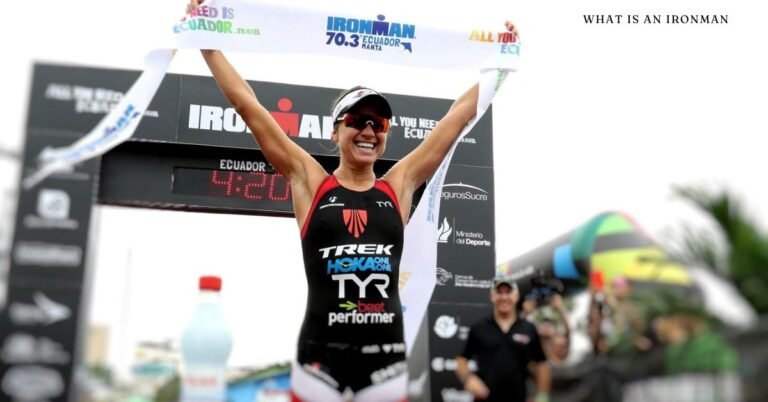Introduction: Understanding What Is an Ironman
When people hear the term Ironman, they often associate it with extreme endurance, perseverance, and peak physical performance. But what is an Ironman exactly? An Ironman is a long-distance triathlon race organized by the World Triathlon Corporation (WTC), consisting of a 2.4-mile (3.86 km) swim, a 112-mile (180.25 km) bike ride, and a 26.2-mile (42.20 km) marathon run, completed consecutively without breaks. This race is widely regarded as one of the most challenging endurance competitions in the world, demanding mental toughness, strategic preparation, and superior fitness levels.
The Ironman race is not just a competition; it represents a lifestyle, a goal for many elite and amateur athletes alike. Originating in 1978 in Hawaii, the race has evolved into a global phenomenon, attracting thousands of participants each year. Whether you’re an aspiring Ironman athlete or simply curious about the event, this guide will provide you with an in-depth understanding of its history, significance, training strategies, and more.
History and Evolution of the Ironman Triathlon
The history of the Ironman Triathlon dates back to 1978, when a group of U.S. Navy SEALs stationed in Hawaii debated which type of athlete was the fittest: swimmers, cyclists, or runners. To settle the debate, John Collins, a Navy commander, proposed combining three already established endurance races in Hawaii—the Waikiki Roughwater Swim (2.4 miles), the Around-Oahu Bike Race (112 miles), and the Honolulu Marathon (26.2 miles)—into a single race. The challenge was set, and 15 athletes took part in the inaugural event. Gordon Haller became the first Ironman champion by finishing in 11 hours, 46 minutes, and 58 seconds.
Over the years, the race gained popularity and expanded worldwide. Today, there are Ironman races held in over 50 countries, each serving as a qualifying event for the Ironman World Championship in Kona, Hawaii. The Kona event remains the most prestigious, attracting the best triathletes from across the globe. Additionally, Ironman 70.3, a half-distance version of the race, has also emerged as a popular alternative for those seeking a challenging yet more manageable endurance race.
Breaking Down the Ironman Triathlon: Swim, Bike, Run
1. The Swim: 2.4 Miles of Open Water Challenge
The Ironman swim is the first leg of the race, typically held in oceans, lakes, or rivers, depending on the event location. Athletes must navigate through open water, dealing with waves, currents, and large groups of swimmers. Unlike pool swimming, there are no lane markers or push-offs from walls, making it a test of both physical endurance and navigational skills.
To excel in the swim portion, triathletes train extensively in open water and practice sighting techniques to stay on course. Wetsuits may be permitted depending on water temperature, offering buoyancy advantages. Drafting (swimming behind another athlete) is a legal strategy that helps conserve energy.
2. The Bike: 112 Miles of Speed and Stamina
After the swim, competitors transition to the cycling portion, covering 112 miles on various terrains, from flat roads to steep hills. This leg is often considered the most strategic because athletes must balance speed with energy conservation for the upcoming marathon.
Successful Ironman cyclists focus on aerodynamics, efficient gear shifting, and maintaining a steady cadence. Proper nutrition and hydration play a crucial role in preventing dehydration and muscle fatigue. Many riders use triathlon-specific bikes with aerodynamic handlebars to reduce wind resistance and improve efficiency.
3. The Run: 26.2-Mile Marathon to the Finish Line
The final leg of the Ironman is the marathon, and it is where mental and physical endurance is pushed to the limit. Running a full 26.2-mile marathon after swimming and biking for hours requires not only a strong aerobic base but also effective pacing and mental fortitude.
To avoid hitting the wall, runners follow strict hydration and nutrition plans, consuming energy gels, sports drinks, and electrolytes. Training often includes brick workouts (bike-to-run transitions) to condition the body for running on fatigued legs. The final stretch is a true test of willpower, as athletes push through exhaustion to cross the coveted finish line.
Ironman Training: How Athletes Prepare for the Ultimate Endurance Race
Training for an Ironman requires a dedicated, well-structured program that lasts 6 to 12 months, depending on experience level. Most training plans include:
- Swim Training: 2-3 sessions per week focusing on endurance, technique, and open-water adaptation.
- Bike Training: 3-4 rides per week emphasizing endurance, speed, and hill climbing.
- Run Training: 3-5 sessions weekly incorporating long-distance running, interval training, and tempo runs.
- Strength Training: 1-2 sessions per week for injury prevention and muscular endurance.
- Nutrition Planning: Practicing race-day nutrition to optimize energy levels.
Athletes often log 10 to 20 hours per week of training, gradually increasing volume to peak fitness before tapering before race day. Mental preparation is equally important, as the race is as much a psychological battle as it is a physical one.
Ironman vs. Other Triathlons: Key Differences
| Feature | Sprint Triathlon | Olympic Triathlon | Ironman 70.3 | Full Ironman |
|---|---|---|---|---|
| Swim | 750m (0.47 miles) | 1.5km (0.93 miles) | 1.9km (1.2 miles) | 3.86km (2.4 miles) |
| Bike | 20km (12.4 miles) | 40km (24.8 miles) | 90km (56 miles) | 180.25km (112 miles) |
| Run | 5km (3.1 miles) | 10km (6.2 miles) | 21.1km (13.1 miles) | 42.2km (26.2 miles) |
| Total Distance | ~25.75km (16 miles) | ~51.5km (32 miles) | ~113km (70.3 miles) | ~226km (140.6 miles) |
Conclusion: Is an Ironman Right for You?
Now that you know what an Ironman is, the question remains: Are you ready for the challenge? Completing an Ironman is a life-changing achievement that requires months of dedicated training, strategic planning, and sheer determination. Whether you’re a seasoned triathlete or an endurance enthusiast, the journey to Ironman status is as rewarding as crossing the finish line.
If you’re considering signing up for an Ironman race, start small, build your endurance gradually, and seek expert guidance. Remember, the only limits that exist are the ones you impose on yourself. If thousands of athletes around the world can do it, so can you!
FAQs
How long does it take to complete an Ironman?
The average Ironman finishing time is between 12 and 14 hours, but elite athletes complete it in under 9 hours.
Do you have to qualify for an Ironman race?
Most Ironman events are open to all athletes, but Kona (World Championship) requires qualification.
What is the Ironman cutoff time?
Athletes must finish the race within 17 hours to be considered an official Ironman finisher.
Can beginners train for an Ironman?
Yes, with dedication and a structured training plan, beginners can complete an Ironman within a year of training.

